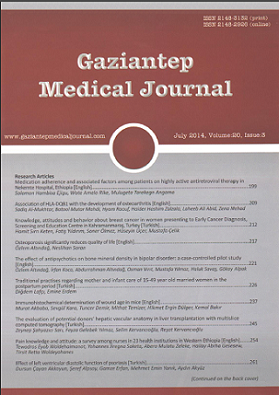A ventilator-associated event in an intensive care unit patient with multiple comorbidities and prolonged mechanical ventilation
Çoklu komorbiditesi ve uzamış mekanik ventilasyonlu olan bir yoğun bakım hastasında ventilatörle ilişkili olay
DOI:
https://doi.org/10.5455/GMJ-30-156516Keywords:
Artificial, Centers for Disease Control and Prevention, complications; mechanical, pneumonia, respiration, ventilator-associated, ventilatorsAbstract
The old Centers for Disease Control and Prevention (CDC) criteria for ventilator-associated pneumonia included a new or a progressive and persistent pulmonary infiltrate, signs of inflammation based on changes in temperature or white blood cell counts, and at least two the following clinical signs (purulent sputum, increased respiratory symptoms, rales or bronchial breath sounds, and/or deteriorating gas exchange). These criteria are difficult to use and resulted in significant variation in reporting rates by hospitals. The CDC recently introduced new criteria for ventilator-associated events. These criteria require a significant deterioration in gas exchange based on an increase in FiO2 (by 20%) and/or the PEEP level (by 3 cmH2O). These new criteria do not consistently identify ventilator-associated pneumonia and have other causes, such as the progression of the primary underlying disease or the development of pulmonary edema. We discuss a patient managed in our medical intensive care unit to illustrate the difficulties in identifying patients with ventilator-associated pneumonia and using the new CDC criteria for ventilator-associated events.
Metrics
References
Slutsky AS, Ranieri VM. Ventilator-induced lung injury. N Engl J Med 2013;369(22):2126-36.
Centers for Disease Control and Prevention. Surveillance for ventilator-associated events. http://www.cdc.gov/nhsn/acute-care-hospital/vae/index. html Accessed on 15 June 2013.
Klompas M. Complications of mechanical ventilation- The CDC’s new surveillance paradigm. New Engl J Med 2013;368(16):1472-5.
Chastre J, Fagon JY. Ventilator-associated pneumonia. Am J Respir Crit Care Med 2002;165(7):867-903.
Kollef MH, Afessa B, Anzueto A, Veremakis C, Kerr KM, Margolis BD, et al. Silver-coated endotracheal tubes and incidence of ventilator-associated pneumonia: the NASCENT randomized trial. JAMA 2008;300(7):805-13.
Dudeck MA, Horan TC, Peterson KD, Allen-Bridson K, Morrell G, Anttila A, et al. National Healthcare Safety Network report, data summary for 2011, device-associated module. Am J Infect Control 2013;41(4):286-300.
Alp E, Voss A. Ventilator associated pneumonia and infection control. Ann Clin Microbiol Antimicrob 2006;5:7.
Safdar N, O’Horo JC, Mak R, Medow J. Agreement between the clinical pulmonary infection score and NHSH criteria for the surveillance of ventilator associated pneumonia. Intern J Infect Control 2013;9:i1.
Tan JC, Guzman-Banzon A, Ayuyao F, DeGuia T. Comparison of CPIS (clinical pulmonary infection score) and clinical criteria in the diagnosis of ventilator-associated pneumonia in ICU complex patients. Phil Heart Center J 2007;13(2):135- 8.
Zilberberg MD, Shorr AF. Ventilator-associated pneumonia: the clinical pulmonary infection score as a surrogate for diagnostics and outcome. Clin Infect Dis 2010;51(Suppl 1):S131-5.
Klompas M, Magill S, Robicsek A, Strymish JM, Kleinman K, Evans RS, et al. Objective surveillance definitions for ventilator-associated pneumonia. Crit Care Med 2012;40(12):3154-61.
Klompas M, Khan Y, Kleinman K, Evans RS, Lloyd JF, Stevenson K, et al. Multicenter evaluation of a novel surveillance paradigm for complications of mechanical ventilation. PLoS One 2011;6(3):e18062.
Hayashi Y, Morisawa K, Klompas M, Jones M, Bandeshe H, Boots R, et al. Toward improved surveillance: he impact of ventilator-associated complications on length of stay and antibiotic use in patients in intensive care units. Clin Infect Dis 2013;56(4):471-7.
Muscedere J, Sinuff T, Heyland DK, Dodek PM, Keenan SP, Wood G, et al. The clinical impact and preventability of ventilator-associated conditions in critically ill patients who are mechanically ventilated. Chest 2013;144(5):1453-60.
Downloads
Published
How to Cite
Issue
Section
License
Copyright (c) 2023 European Journal of Therapeutics

This work is licensed under a Creative Commons Attribution-NonCommercial 4.0 International License.
The content of this journal is licensed under a Creative Commons Attribution-NonCommercial 4.0 International License.


















